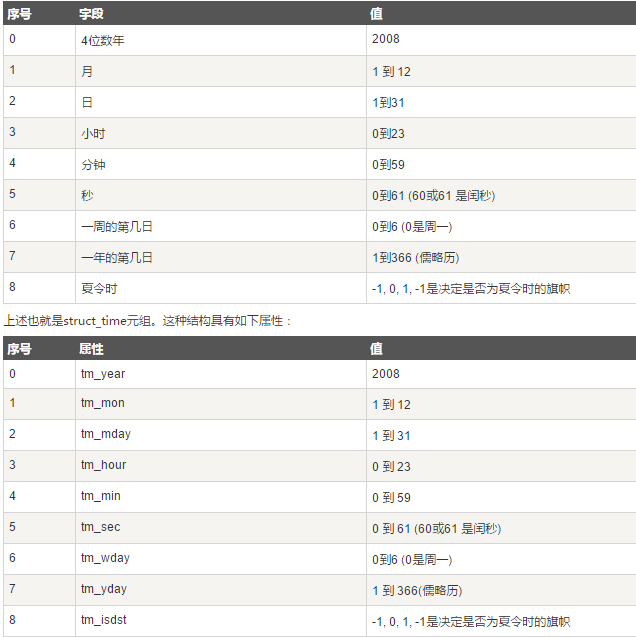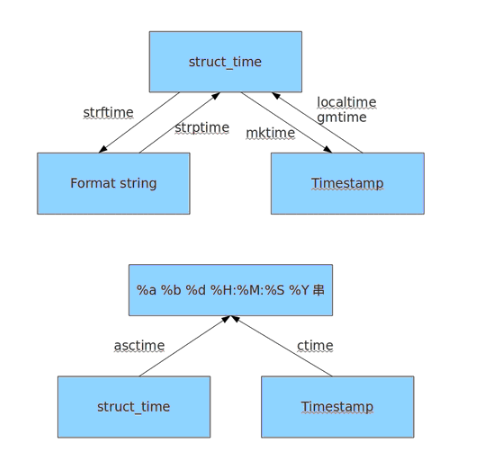Python3之时间模块time & datetime & calendar
一. 简介
python 提供很多方式处理日期与时间,转换日期格式是一个常见的功能。
时间元组:很多python函数用一个元组装起来的9组数字处理时间。

python中时间日期格式化符号:
%y 两位数的年份表示(00-99)
%Y 四位数的年份表示(000-9999)
%m 月份(01-12)
%d 月内中的一天(0-31)
%H 24小时制小时数(0-23)
%I 12小时制小时数(01-12)
%M 分钟数(00=59)
%S 秒(00-59)
%a 本地简化星期名称
%A 本地完整星期名称
%b 本地简化的月份名称
%B 本地完整的月份名称
%c 本地相应的日期表示和时间表示
%j 年内的一天(001-366)
%p 本地A.M.或P.M.的等价符
%U 一年中的星期数(00-53)星期天为星期的开始
%w 星期(0-6),星期天为星期的开始
%W 一年中的星期数(00-53)星期一为星期的开始
%x 本地相应的日期表示
%X 本地相应的时间表示
%Z 当前时区的名称
%% %号本身
二. time模块
时间相关操作,时间有三种表示方式:
- 时间戳 1970年1月1日之后的秒,即:time.time()
- 格式化的字符串 2014-11-11 11:11, 即:time.strftime('%Y-%m-%d')
- 结构化时间 元组包含了:年、日、星期等... time.struct_time 即:time.localtime()
time.time()
返回当前时间的时间戳(1970纪元后经过的浮点秒数)。
时间戳单位最适于做日期运算。但是1970年之前的日期就无法以此表示了。太遥远的日期也不行,UNIX和Windows只支持到2038年。
>>> import time
>>> print(time.time())
1459999336.1963577
time.mktime(tupletime)
接受时间元组并返回时间辍(1970纪元后经过的浮点秒数)。
Python time.mktime() 函数执行与gmtime(), localtime()相反的操作,它接收struct_time对象作为参数,返回用秒数来表示时间的浮点数。
如果输入的值不是一个合法的时间,将触发 OverflowError 或 ValueError。
#!/usr/bin/python3
import time t = (2016, 2, 17, 17, 3, 38, 1, 48, 0)
secs = time.mktime( t )
print ("time.mktime(t) : %f" % secs)
print ("asctime(localtime(secs)): %s" % time.asctime(time.localtime(secs))) 以上实例输出结果为:
time.mktime(t) : 1455699818.000000
asctime(localtime(secs)): Wed Feb 17 17:03:38 2016
time.gmtime([secs])
接收时间辍(1970纪元后经过的浮点秒数)并返回格林威治天文时间下的时间元组t。注:t.tm_isdst始终为0
>>> import time
>>> print ("gmtime :", time.gmtime(1455508609.34375))
gmtime : time.struct_time(tm_year=2016, tm_mon=2, tm_mday=15, tm_hour=3, tm_min=56, tm_sec=49, tm_wday=0, tm_yday=46, tm_isdst=0)
time.localtime([secs])
接收时间辍(1970纪元后经过的浮点秒数)并返回当地时间下的时间元组t(t.tm_isdst可取0或1,取决于当地当时是不是夏令时)。
>>> import time
>>> print ("localtime(): ", time.localtime(1455508609.34375))
localtime(): time.struct_time(tm_year=2016, tm_mon=2, tm_mday=15, tm_hour=11, tm_min=56, tm_sec=49, tm_wday=0, tm_yday=46, tm_isdst=0)
time.mktime(tupletime)
接受时间元组并返回时间辍(1970纪元后经过的浮点秒数)。
Python time mktime() 函数执行与gmtime(), localtime()相反的操作,它接收struct_time对象作为参数,返回用秒数来表示时间的浮点数。
如果输入的值不是一个合法的时间,将触发 OverflowError 或 ValueError。
#!/usr/bin/python3
import time t = (2016, 2, 17, 17, 3, 38, 1, 48, 0)
secs = time.mktime( t )
print ("time.mktime(t) : %f" % secs)
print ("asctime(localtime(secs)): %s" % time.asctime(time.localtime(secs))) 以上实例输出结果为:
time.mktime(t) : 1455699818.000000
asctime(localtime(secs)): Wed Feb 17 17:03:38 2016
time.strftime(fmt[,tupletime])
接收以时间元组,并返回以可读字符串表示的当地时间,格式由fmt决定。 >>> import time
>>> print (time.strftime("%Y-%m-%d %H:%M:%S", time.localtime()))
2016-04-07 11:18:05
time.strptime(str,fmt='%a %b %d %H:%M:%S %Y')
根据fmt的格式把一个时间字符串解析为时间元组。
>>> import time
>>> struct_time = time.strptime("30 Nov 00", "%d %b %y")
>>> print ("返回元组: ", struct_time)
返回元组: time.struct_time(tm_year=2000, tm_mon=11, tm_mday=30, tm_hour=0, tm_min=0, tm_sec=0, tm_wday=3, tm_yday=335, tm_isdst=-1)
time.altzone
返回格林威治西部的夏令时地区的偏移秒数。如果该地区在格林威治东部会返回负值(如西欧,包括英国)。对夏令时启用地区才能使用。
>>> import time
>>> print ("time.altzone %d " % time.altzone)
time.altzone -28800
time.asctime([tupletime])
接受时间元组并返回一个可读的形式为"Tue Dec 11 18:07:14 2008"(2008年12月11日 周二18时07分14秒)的24个字符的字符串。
>>> import time
>>> t = time.localtime()
>>> print ("time.asctime(t): %s " % time.asctime(t))
time.asctime(t): Thu Apr 7 10:36:20 2016
time.clock()
用以浮点数计算的秒数返回当前的CPU时间。用来衡量不同程序的耗时,比time.time()更有用。
#!/usr/bin/python3
import time def procedure():
time.sleep(2.5) # time.clock
t0 = time.clock()
procedure()
print (time.clock() - t0) # time.time
t0 = time.time()
procedure()
print (time.time() - t0)
以上实例输出结果为:
5.000000000000143e-05
2.5020556449890137
time.ctime([secs])
作用相当于asctime(localtime(secs)),未给参数相当于asctime()
>>> import time
>>> print ("time.ctime() : %s" % time.ctime())
time.ctime() : Thu Apr 7 10:51:58 2016
time.sleep(secs)
推迟调用线程的运行,secs指秒数。
#!/usr/bin/python3
import time print ("Start : %s" % time.ctime())
time.sleep( 5 )
print ("End : %s" % time.ctime())
time.tzset()
根据环境变量TZ重新初始化时间相关设置。
标准TZ环境变量格式:
std offset [dst [offset [,start[/time], end[/time]]]] 参数:
std 和 dst:三个或者多个时间的缩写字母。传递给 time.tzname.
offset: 距UTC的偏移,格式: [+|-]hh[:mm[:ss]] {h=0-23, m/s=0-59}。
start[/time], end[/time]: DST 开始生效时的日期。格式为 m.w.d — 代表日期的月份、周数和日期。w=1 指月份中的第一周,而 w=5 指月份的最后一周。'start' 和 'end' 可以是以下格式之一:
Jn: 儒略日 n (1 <= n <= 365)。闰年日(2月29)不计算在内。
n: 儒略日 (0 <= n <= 365)。 闰年日(2月29)计算在内
Mm.n.d: 日期的月份、周数和日期。w=1 指月份中的第一周,而 w=5 指月份的最后一周。
time:(可选)DST 开始生效时的时间(24 小时制)。默认值为 02:00(指定时区的本地时间)。 #!/usr/bin/python3
import time
import os os.environ['TZ'] = 'EST+05EDT,M4.1.0,M10.5.0'
time.tzset()
print (time.strftime('%X %x %Z')) os.environ['TZ'] = 'AEST-10AEDT-11,M10.5.0,M3.5.0'
time.tzset()
print (time.strftime('%X %x %Z'))
以上实例输出结果为:
23:25:45 04/06/16 EDT
13:25:45 04/07/16 AEST
time.timezone
属性time.timezone是当地时区(未启动夏令时)距离格林威治的偏移秒数(>0,美洲;<=0大部分欧洲,亚洲,非洲)。
time.tzname
属性time.tzname包含一对根据情况的不同而不同的字符串,分别是带夏令时的本地时区名称,和不带的。
时间装换图:

三. datetime模块
print(datetime.now()) # 获取当前时间 2015-03-29 16:23:20.618564
print(datetime.date.fromtimestamp(time.time()-864400) ) #2016-01-16 将时间戳转成日期格式
current_time = datetime.datetime.now() #
print(current_time) #输出2016-01-26 19:04:30.335935
print(current_time.timetuple()) #返回struct_time格式 #datetime.replace([year[, month[, day[, hour[, minute[, second[, microsecond[, tzinfo]]]]]]]])
print(current_time.replace(2014,9,12)) #输出2014-09-12 19:06:24.074900,返回当前时间,但指定的值将被替换 str_to_date = datetime.datetime.strptime("21/11/06 16:30", "%d/%m/%y %H:%M") #将字符串转换成日期格式
new_date = datetime.datetime.now() + datetime.timedelta(days=10) #比现在加10天
new_date = datetime.datetime.now() + datetime.timedelta(days=-10) #比现在减10天
new_date = datetime.datetime.now() + datetime.timedelta(hours=-10) #比现在减10小时
new_date = datetime.datetime.now() + datetime.timedelta(seconds=120) #比现在+120s
print(new_date)
datetime转换为timestamp
>>>from datetime import datetime
>>> dt = datetime(2017,3,29,12,20) # 用指定日期创建datetime
>>> dt.timestamp() # 把datetime转换为timestamp
1490761200.0
在Python中的时间戳是一个浮点小数,如果有小数位,小数位表示毫秒数。其他如Java和JavaScript中的时间戳使用整数表示毫秒数,这种情况下只需要将时间戳除以1000就可以得到和Python一样的浮点表示法。
timestamp 转换为 datetime
>>> from datetime import datetime
>>> t = 1490761200.0
>>> print(datetime.fromtimestamp(t)) # 本地时间转换
2017-03-29 12:20:00
>>> print(datetime.utcfromtimestamp(t)) # UTC时间转换
2017-03-29 04:20:00
str转换为datetime
>>> from datetime import datetime
>>> cday = datetime.strptime('2016-01-03 16:15:56', '%Y-%m-%d %H:%M:%S')
>>> print(cday)
2016-01-03 16:15:56
datetime转换为str
>>> from datetime import datetime
>>> now = datetime.now()
>>> print(now.strftime('%a, %b %d %H:%M'))
Wed, Mar 29 16:18
四. calendar模块
此模块的函数都是日历相关,星期一是每周的第一天,星期天是最后一天。
calendar.calendar(year,w=2,l=1,c=6)
返回一个多行字符串格式的year年年历,3个月一行,间隔距离为c。 每日宽度间隔为w字符。每行长度为21* W+18+2* C。l是每星期行数。
calendar.firstweekday( )
返回当前每周起始日期的设置。默认情况下,首次载入caendar模块时返回0,即星期一。
calendar.isleap(year)
是闰年返回True,否则为false。
calendar.leapdays(y1,y2)
返回在Y1,Y2两年之间的闰年总数。
calendar.month(year,month,w=2,l=1)
返回一个多行字符串格式的year年month月日历,两行标题,一周一行。每日宽度间隔为w字符。每行的长度为7* w+6。l是每星期的行数。
calendar.monthcalendar(year,month)
返回一个整数的单层嵌套列表。每个子列表装载代表一个星期的整数。Year年month月外的日期都设为0;范围内的日子都由该月第几日表示,从1开始。
calendar.monthrange(year,month)
返回两个整数。第一个是该月的星期几的日期码,第二个是该月的日期码。日从0(星期一)到6(星期日);月从1到12。
calendar.prcal(year,w=2,l=1,c=6)
相当于 print calendar.calendar(year,w,l,c).
calendar.prmonth(year,month,w=2,l=1)
相当于 print calendar.calendar(year,w,l,c)。
calendar.setfirstweekday(weekday)
设置每周的起始日期码。0(星期一)到6(星期日)。
calendar.timegm(tupletime)
和time.gmtime相反:接受一个时间元组形式,返回该时刻的时间辍(1970纪元后经过的浮点秒数)。
calendar.weekday(year,month,day)
返回给定日期的日期码。0(星期一)到6(星期日)。月份为 1(一月) 到 12(12月)。
Python3之时间模块time & datetime & calendar的更多相关文章
- python 时间模块(time ,datetime,calendar)
Python中提供了时间相关的内置模块,我们主要用的是:time模块.datetime模块和calendar模块 ⽇期格式化的标准: %y 两位数的年份表示(00-99) %Y 四位数的年份表示(00 ...
- Python3之时间模块详述
Python3之时间模块 time & datetime & calendar 一. 概述 python 提供很多方式处理日期与时间,转换日期格式是一个常见的功能. 时间元组:很多p ...
- Python模块 - time,datetime,calendar
time模块 localtime 当前时间的struct_time形式 >>> time.localtime() time.struct_time(tm_year=2015, tm_ ...
- Day 16 : Python 时间模块[time,]datetime[]及第三方模块的下载与安装
在进行python程序开发时,除了可以使用python内置的标准模块外,还右许多第三方模块使用,可以在python官网找到. 在使用第三方模块时,需要下载并安装此模块,然后就可以使用标准模块一样导入并 ...
- python3中time模块与datetime模块的简单用法
__author__ = "JentZhang" import time # Timestamp 时间戳 print("Timestamp 时间戳:") pri ...
- Python3对时间模块的操作
python中使用time和datetime来进行时间操作 import time import datetime # 获取时间戳 time.time() # 1544601181.549864 # ...
- Python时间模块datetime用法
时间模块datetime是python内置模块,datetime是Python处理日期和时间的标准库. 1,导入时间模块 from datetime import datetime 2,实例 from ...
- python 学习笔记 13 -- 经常使用的时间模块之time
Python 没有包括相应日期和时间的内置类型.只是提供了3个相应的模块,能够採用多种表示管理日期和时间值: * time 模块由底层C库提供与时间相关的函数.它包括一些函数用于获取时钟时间和处 ...
- 【转】Python3 日期时间 相关模块(time(时间) / datatime(日期时间) / calendar(日历))
Python3 日期时间 相关模块(time(时间) / datatime(日期时间) / calendar(日历)) 本文由 Luzhuo 编写,转发请保留该信息. 原文: http://blog. ...
随机推荐
- leetcode486
public class Solution { public bool PredictTheWinner(int[] nums) { // int n = nums.Length; // int[,] ...
- 新浪微博logo已经去掉了“新浪”二字
如果有一天我能做出一个产品,它的命名就以我所在的行业命名该多好啊,可惜那只是一个梦.但这样的梦新浪微博却实现了,今天我登陆新浪微博的时候发 现logo已经去掉了“新浪”二字,我开始还以为我自己的电脑网 ...
- libevent源码深度剖析三
libevent源码深度剖析三 ——libevent基本使用场景和事件流程 张亮 1 前言 学习源代码该从哪里入手?我觉得从程序的基本使用场景和代码的整体处理流程入手是个不错的方法,至少从个人的经验上 ...
- mongo_2 $in 和 $all 区别
in 只需满足( )内的某一个值即可, 而$all 必须满足[ ]内的所有值, > db.table1.find({}); { "_id" : ObjectId(" ...
- quilljs 一款简单轻量的富文本编辑器(适合移动端)
quilljs入门使用教程: quill.js是一款强大的现代富文本编辑器插件.该富文本编辑器插件支持所有的现代浏览器.平板电脑和手机.它提供了文本编辑器的所有功能,并为开发者提供大量的配置参数和方法 ...
- Linux pkg-config命令
一.简介 pkg-config用来检索系统中安装库文件的信息.典型的是用作库的编译和连接. 二.实例 http://blog.chinaunix.net/uid-20595934-id-1918368 ...
- 为什么说Java String 类型的值是不可改变的?
String对象是不可变的,它的内容是不能改变的.下列代码会改变字符串的内容吗? 1 2 String s = "Java"; s = "HTML"; 答案是不 ...
- LaTeX入门教程(一)
LaTeX(LATEX,音译“拉泰赫”)是一种基于ΤΕΧ的排版系统,由美国计算机学家莱斯利·兰伯特(Leslie Lamport)在20世纪80年代初期开发,利用这种格式,即使使用者没有排版和程序设计 ...
- Luogu 4473 [国家集训队]飞飞侠
BZOJ 2143 新技能:并查集优化最短路. 暴力最短路是$O(n^4)$的,然后拿个线段树优化一下连边就$O($能过$)$了. 但是这样都太慢了. 我们考虑一个点如果之前被更新过了,那么之后就不会 ...
- Oracle——单行函数
两种 SQL 函数 单行函数 字符函数 大小写控制函数 SELECT employee_id, last_name, department_id FROM employees WHERE last_n ...
